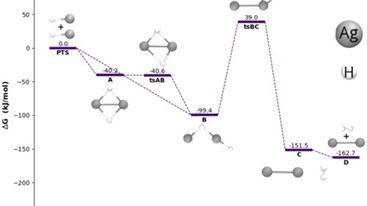Sunday, 14/12/2025 | 06:36 GMT+7
Plants fuel the world with their ability to convert sunlight into a usable form of energy. Now, the Department of Energy is putting up $122 million to help humans capture the energy of the sun and create renewable liquid fuels through "artificial photosynthesis."
![]() Lawrence Berkeley Laboratory and the California
Institute of Technology in
Lawrence Berkeley Laboratory and the California
Institute of Technology in
![]() "The sun is by far the largest source of
energy available to man, but we must find a way to cheaply capture, convert and
store its energy if we are to build a complete clean energy system," said
Nathan Lewis, a Caltech chemist who will serve as director of the sun-to-energy
research collaboration, called the Joint Center for Artificial Photosynthesis.
"The sun is by far the largest source of
energy available to man, but we must find a way to cheaply capture, convert and
store its energy if we are to build a complete clean energy system," said
Nathan Lewis, a Caltech chemist who will serve as director of the sun-to-energy
research collaboration, called the Joint Center for Artificial Photosynthesis.

![]() Scientists acknowledge the formidable
challenge of creating tiny devices that will mimic the microscopic inner
workings of one of nature's more intricate processes — photosynthesis. Plants
are able to absorb sunlight, water and carbon dioxide, and in a marvel of
nature's ingenuity, yield oxygen and carbohydrates that fuel most life on
Earth.
Scientists acknowledge the formidable
challenge of creating tiny devices that will mimic the microscopic inner
workings of one of nature's more intricate processes — photosynthesis. Plants
are able to absorb sunlight, water and carbon dioxide, and in a marvel of
nature's ingenuity, yield oxygen and carbohydrates that fuel most life on
Earth.
![]() But instead of yielding a simple
carbohydrate, artificial photosynthesis would be designed to create oxygen and
liquid fuels such as hydrocarbons or alcohols that could be directly pumped
into vehicles, without additional, costly refinement.
But instead of yielding a simple
carbohydrate, artificial photosynthesis would be designed to create oxygen and
liquid fuels such as hydrocarbons or alcohols that could be directly pumped
into vehicles, without additional, costly refinement.
![]() It's not a new quest, but the modest
successes thus far have been confined to basic research labs, many steps from
practical applications. The techniques also sometimes have required rare,
expensive materials that would make any ultimate commercial scale-up
impractical. But advances in nanotechnology, a field in which the
It's not a new quest, but the modest
successes thus far have been confined to basic research labs, many steps from
practical applications. The techniques also sometimes have required rare,
expensive materials that would make any ultimate commercial scale-up
impractical. But advances in nanotechnology, a field in which the
![]() Photosynthesis "happens on the nano
scale," said Paul Alivisatos, director of the Lawrence Berkeley
Laboratory. "There's really a new environment with all the nanotechnology
that's been developed."
Photosynthesis "happens on the nano
scale," said Paul Alivisatos, director of the Lawrence Berkeley
Laboratory. "There's really a new environment with all the nanotechnology
that's been developed."
With nanotechnology, scientists can create "nanowires" that are one-1,000th the size of a human hair, along with elements like nanocrystals. These tiny machine parts are designed to replicate photosynthesis on a scale closer to what happens inside a leaf.
Can human ingenuity finally master this complex process? "Oh yes, totally. This is doable," Alivisatos said. "The problems that we face are really specific technical ones that can be worked out."
The
![]() The five-year artificial photosynthesis
project will get $22 million in funding this fiscal year, and $25 million per
year for the remaining four years, subject to Congressional approval.
The five-year artificial photosynthesis
project will get $22 million in funding this fiscal year, and $25 million per
year for the remaining four years, subject to Congressional approval.
The artificial photosynthesis hub "has the potential to
reduce our dangerous dependence on foreign oil, increase our national security
and create jobs in
![]() Rep. Barbara Lee, D-Oakland, said that it
would create 100 new jobs, not including construction and other contract jobs.
It also engages the work of an estimated 200 scientists statewide. Other
universities involved in the artificial photosynthesis hub include SLAC
National Accelerator Laboratory at Stanford, Đại học
Rep. Barbara Lee, D-Oakland, said that it
would create 100 new jobs, not including construction and other contract jobs.
It also engages the work of an estimated 200 scientists statewide. Other
universities involved in the artificial photosynthesis hub include SLAC
National Accelerator Laboratory at Stanford, Đại học
![]() That joint effort among researchers around
the state is critical to the project's success, Alivisatos said.
That joint effort among researchers around
the state is critical to the project's success, Alivisatos said.
"I think it's essential really, because it's a very complex process with many, many parts to it," he said. "It's a classic example of a problem that needs to have a team approach to it."
contracostatimes.com








 Enhancing capacity to develop and implement energy efficiency policies at local level
Enhancing capacity to develop and implement energy efficiency policies at local level
 Bosch Vietnam Plant Benefits from Investment in Energy Efficiency
Bosch Vietnam Plant Benefits from Investment in Energy Efficiency
 Webinar 2: “Financial Support for Energy Efficiency Enterprises – Opportunities and Challenges”
Webinar 2: “Financial Support for Energy Efficiency Enterprises – Opportunities and Challenges”
 Vietnamese enterprises achieve green growth and cut costs through energy efficiency
Vietnamese enterprises achieve green growth and cut costs through energy efficiency
 Capacity Building for Program Implementing Entity
Capacity Building for Program Implementing Entity
 Promoting Energy Efficiency for Technical Staff of Brick and Ceramic Sector
Promoting Energy Efficiency for Technical Staff of Brick and Ceramic Sector
 Enhance Energy Efficiency Knowledge for Managers of Cement Industrial Enterprises
Enhance Energy Efficiency Knowledge for Managers of Cement Industrial Enterprises